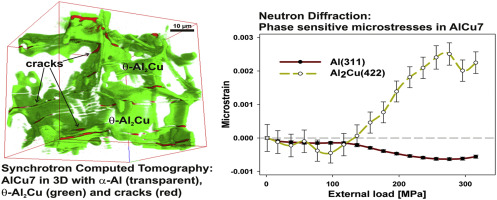当前位置:
X-MOL 学术
›
J. Alloys Compd.
›
论文详情
Our official English website, www.x-mol.net, welcomes your
feedback! (Note: you will need to create a separate account there.)
Elasto-plastic deformation in Al-Cu cast alloys for engine components
Journal of Alloys and Compounds ( IF 5.8 ) Pub Date : 2019-02-01 , DOI: 10.1016/j.jallcom.2018.10.109 M. Schöbel , R. Fernández , R. Koos , J. Bernardi
Journal of Alloys and Compounds ( IF 5.8 ) Pub Date : 2019-02-01 , DOI: 10.1016/j.jallcom.2018.10.109 M. Schöbel , R. Fernández , R. Koos , J. Bernardi

|
Abstract High efficiency, increasing power densities, lower weight and pollution reduction require new materials for combustion engine components in order to withstand the higher thermo-mechanical loads. Cast Al-Si alloys are used for cylinder heads where they combine light weight, good castability and suitable mechanical properties. Despite casting difficulties and their vulnerability to hot tearing these Al-Cu alloys can be used as candidates to achieve even better mechanical properties at elevated temperatures. These alloys are formed by a ductile precipitation hardening α-Al matrix and brittle intermetallics, mostly Al2Cu. Tensile deformation of AlCu4 as cast and AlCu7 solutionized and aged conditions is investigated by combined application of non-destructive testing and imaging methods (using electron, neutron and synchrotron radiation) to study the stress distribution between the Al2Cu structures and the surrounding Al matrix. The external loads are transferred into the microstructure by strain control due to percolating eutectic structures in AlCu4 and AlCu7 as cast. Homogenization by solution treatment and age hardening significantly increases the strength, although stress controlled behavior becomes dominant. (Some damage tolerance is observed in the as cast as well as in the heat treated condition, as load is transferred from particles which were broken first to the remaining ones maintaining some deformation strengthening.) The stress-strain behavior of the samples is compared, conclusions on deformation mechanisms and internal architectures are drawn.
中文翻译:

发动机部件用铝铜铸造合金的弹塑性变形
摘要 高效率、增加功率密度、减轻重量和减少污染需要用于内燃机部件的新材料,以承受更高的热机械负荷。铸造铝硅合金用于气缸盖,它们结合了重量轻、可铸性好和合适的机械性能。尽管铸造困难且容易热裂,但这些 Al-Cu 合金可作为候选材料,在高温下获得更好的机械性能。这些合金由韧性沉淀硬化 α-Al 基体和脆性金属间化合物(主要是 Al2Cu)形成。通过无损检测和成像方法(使用电子、中子和同步辐射)来研究 Al2Cu 结构和周围 Al 基体之间的应力分布。由于铸造时 AlCu4 和 AlCu7 中渗透的共晶结构,外部载荷通过应变控制转移到显微组织中。通过固溶处理和时效硬化的均质化显着提高了强度,尽管应力控制行为成为主导。(在铸态和热处理条件下观察到一些损伤容限,因为载荷从首先破碎的颗粒转移到保持一定变形强化的其余颗粒。)比较样品的应力应变行为,得出关于变形机制和内部结构的结论。由于铸造时 AlCu4 和 AlCu7 中渗透的共晶结构,外部载荷通过应变控制转移到显微组织中。通过固溶处理和时效硬化的均质化显着提高了强度,尽管应力控制行为成为主导。(在铸态和热处理条件下观察到一些损伤容限,因为载荷从首先破碎的颗粒转移到保持一定变形强化的其余颗粒。)比较样品的应力应变行为,得出关于变形机制和内部结构的结论。由于铸造时 AlCu4 和 AlCu7 中渗透的共晶结构,外部载荷通过应变控制转移到显微组织中。通过固溶处理和时效硬化的均质化显着提高了强度,尽管应力控制行为成为主导。(在铸态和热处理条件下观察到一些损伤容限,因为载荷从首先破碎的颗粒转移到保持一定变形强化的其余颗粒。)比较样品的应力应变行为,得出关于变形机制和内部结构的结论。通过固溶处理和时效硬化的均质化显着提高了强度,尽管应力控制行为成为主导。(在铸态和热处理条件下观察到一些损伤容限,因为载荷从首先破碎的颗粒转移到保持一定变形强化的其余颗粒。)比较样品的应力应变行为,得出关于变形机制和内部结构的结论。通过固溶处理和时效硬化的均质化显着提高了强度,尽管应力控制行为成为主导。(在铸态和热处理条件下观察到一些损伤容限,因为载荷从首先破碎的颗粒转移到保持一定变形强化的其余颗粒。)比较样品的应力应变行为,得出关于变形机制和内部结构的结论。
更新日期:2019-02-01
中文翻译:

发动机部件用铝铜铸造合金的弹塑性变形
摘要 高效率、增加功率密度、减轻重量和减少污染需要用于内燃机部件的新材料,以承受更高的热机械负荷。铸造铝硅合金用于气缸盖,它们结合了重量轻、可铸性好和合适的机械性能。尽管铸造困难且容易热裂,但这些 Al-Cu 合金可作为候选材料,在高温下获得更好的机械性能。这些合金由韧性沉淀硬化 α-Al 基体和脆性金属间化合物(主要是 Al2Cu)形成。通过无损检测和成像方法(使用电子、中子和同步辐射)来研究 Al2Cu 结构和周围 Al 基体之间的应力分布。由于铸造时 AlCu4 和 AlCu7 中渗透的共晶结构,外部载荷通过应变控制转移到显微组织中。通过固溶处理和时效硬化的均质化显着提高了强度,尽管应力控制行为成为主导。(在铸态和热处理条件下观察到一些损伤容限,因为载荷从首先破碎的颗粒转移到保持一定变形强化的其余颗粒。)比较样品的应力应变行为,得出关于变形机制和内部结构的结论。由于铸造时 AlCu4 和 AlCu7 中渗透的共晶结构,外部载荷通过应变控制转移到显微组织中。通过固溶处理和时效硬化的均质化显着提高了强度,尽管应力控制行为成为主导。(在铸态和热处理条件下观察到一些损伤容限,因为载荷从首先破碎的颗粒转移到保持一定变形强化的其余颗粒。)比较样品的应力应变行为,得出关于变形机制和内部结构的结论。由于铸造时 AlCu4 和 AlCu7 中渗透的共晶结构,外部载荷通过应变控制转移到显微组织中。通过固溶处理和时效硬化的均质化显着提高了强度,尽管应力控制行为成为主导。(在铸态和热处理条件下观察到一些损伤容限,因为载荷从首先破碎的颗粒转移到保持一定变形强化的其余颗粒。)比较样品的应力应变行为,得出关于变形机制和内部结构的结论。通过固溶处理和时效硬化的均质化显着提高了强度,尽管应力控制行为成为主导。(在铸态和热处理条件下观察到一些损伤容限,因为载荷从首先破碎的颗粒转移到保持一定变形强化的其余颗粒。)比较样品的应力应变行为,得出关于变形机制和内部结构的结论。通过固溶处理和时效硬化的均质化显着提高了强度,尽管应力控制行为成为主导。(在铸态和热处理条件下观察到一些损伤容限,因为载荷从首先破碎的颗粒转移到保持一定变形强化的其余颗粒。)比较样品的应力应变行为,得出关于变形机制和内部结构的结论。











































 京公网安备 11010802027423号
京公网安备 11010802027423号